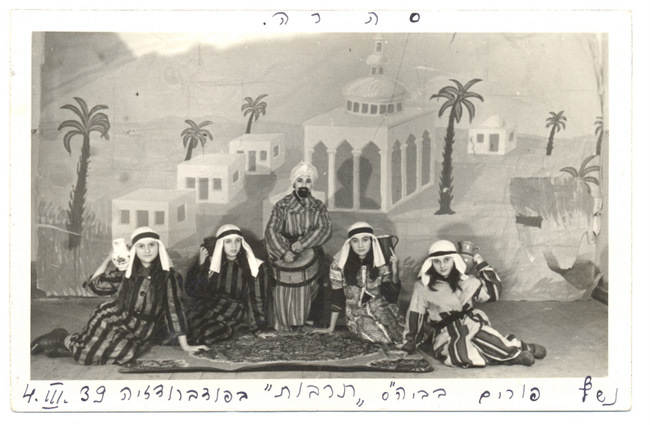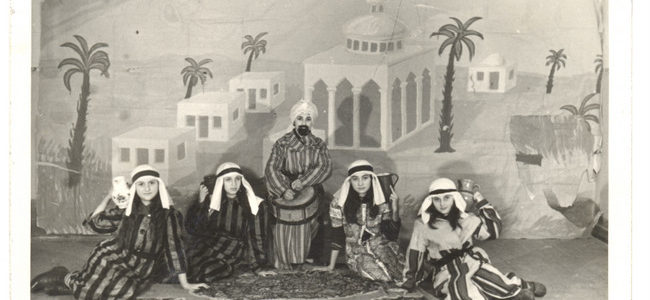Photo: Tarbut Gymnasium students in Pabradė prepared for the Purimspiel, March 3, 1939. Courtesy YIVO.
Purim starts February 25 this year. Purim is the happiest of Jewish holidays dedicated to remembering the miraculous salvation of the Jewish people from destruction. Traditionally the triangular pastry Hamatasch are eaten on this day and the Lithuanian Jewish Community will share them with the leaders of the state this year as well.
“The essence of Purim is to celebrate life in all its fullness. This is a happy holiday, on this day you need to eat deliciously and much, especially the traditional hamantaschen pastry. This traditional treat reminds us that the plans of evildoers often turns back upon them, while wise rulers always receive the help to make the right decisions. We will also be sending hamantaschen pastry to the leaders of the country, wishing them to make wise decisions beneficial to the people,” Lithuanian Jewish Community chairwoman Faina Kukliansky said.
Vilnius Jewish Religious Community director Simas Levinas recalls the Purim story which reaches back into biblical times when the Jewish people were exiled from Jerusalem to Babylon. Although the king married the Jewish beauty Esther, the magnates and bureaucrats of Babylon really hated the Jews in their country, who weren’t there by their own choice. The vizier Haman came up with a plan to exterminate all Jews and cast lots (פור) to discover an auspicious time for this.

Tarbut Gymnasium students in Pabradė prepared for the Purimspiel, March 3, 1939. Courtesy YIVO.
February 25 (starting at dusk on Adar 14 this year on the Jewish calendar) was chosen by lots for the day the sentence would be executed: “Purim also means divination, just that that fateful fortune-telling turned back against the evildoers themselves. At the last moment Queen Esther persuaded her husband, and the Jewish people were saved. The king punished vizier Haman himself and his ten sons for their disreputable schemes. The holiday is called Purim based on the word פור “pur” and all events connected with it are recorded in Megilat Ester, or the Book of Esther,” Simas Levinas explained.
The Purim traditions–having fun, eating delicious food and lots of it, visiting neighbors and friends bearing gifts, dressing up in different costumes–have come down to our times. Purim is not a commemoration of tragedy but of rescue from that tragedy and therefore it is celebrated loudly and with gusto. The holiday is filled with fun and games, the sense of community and the belief the Jewish people are strong and able to overcome all misfortune. In Israel the holiday of Purim is celebrated in a grand manner, very colorfully, with a fun carnival.
Although this year the holiday will take place at home, Faina Kukliansky invites you to make your own hamantaschen at home, and is sharing a recipe which her family has preserved from the period in between the two world wars.
“Most likely this recipe was used even earlier and it recalls the time when you smell this pastry in the Vilnius Old Town and in many Lithuanian towns and cities where Jews lived. While you can find this treat at the Bagel Shop Café, it’s much more fun to make it yourself,” Faina Kukliansky said. Litvak hamantaschen are a triangular pastry made of leavened dough, traditionally filled with poppy seeds.
Faina Kukliansky’s hamantaschen recipe:
For the dough you’ll need:
125 ml milk
1 tablespoon sugar
1 teaspoon dry yeast
1/2 teaspoon salt
500 ml flour
100 g butter
1 egg yolk
Poppy filling:
1/2 cup milk
100 g sugar
100 g honey
100 g ground poppy seeds
some grated orange peel or zest
a bit of lemon juice
1/4 cup raisins (if you have them)
Method of preparation:
Mix the warm milk with the yeast, egg yolk and sugar and let sit in a warm place for a while. Mix the flour with the salt, then poor the yeast mixture into the middle, mix in the warm butter and knead the resulting dough for from 5 to 10 minutes, until the dough becomes pliable and elastic. Cover the dough and let sit in a warm place for 20 minutes.
Separate a third of the dough. Pinch this into 10 equal-sized balls. Spread each ball with a rolling pin or make it thin with your fingers, making round circiles about 3 to 5 mm thick and 10 mm [cm?] wide. You can use the rolling pin to flatten the entire piece of dough and then cut circles out of it using a dish or cup as well.
Place 1 or 2 teaspoons of the filling in the middle of each dough circle and fold the edges of the dough over from three corners such that you still see a bit of the filling from the top. Brush the top with the whipped egg.
Preheat the over to 180° C.
Place the pastry on a tray covered with cooking paper which is lightly buttered. Bake for 20 to 25 minutes until the pastries turn a nice brown color. Leave on the tray for 5 to minutes after removing from oven, then remove them carefully and let them entirely cool down on a rack. Sprinkle with powdered sugar before serving.
Bon appétit!


